| Listing 1 - 10 of 26 | << page >> |
Sort by
|
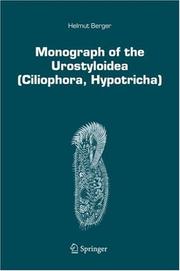
ISBN: 1280864915 9786610864911 1402052731 1402052723 Year: 2006 Volume: v. 85 Publisher: Dordrecht, the Netherlands : Springer,
Abstract | Keywords | Export | Availability | Bookmark
 Loading...
Loading...Choose an application
- Reference Manager
- EndNote
- RefWorks (Direct export to RefWorks)
This monograph is the second of a series treating the hypotrichs, a major part of the spirotrichous ciliates. The urostyloids are characterised by a zigzag-arrangement of the ventral cirri. Like the first part of the series, the Oxytrichidae, it summarises the morphological, morphogenetic, faunistic, and ecological data from the past 230 years, scattered in more than 1300 references from all over the world. Dichotomous keys lead to 36 genera and subgenera comprising 153 species illustrated by more than 2100 figures, including original ones. The treatise offers taxonomists, cell biologists, and
Hypotrichida --- Hypotricha --- Hypotrichia --- Hypotrichina --- Hypotrichorida --- Hypotrichous ciliates --- Hypotrichs --- Spirotricha --- Invertebrates. --- Aquatic biology. --- Zoology. --- Freshwater & Marine Ecology. --- Animal Systematics/Taxonomy/Biogeography. --- Biology --- Natural history --- Animals --- Hydrobiology --- Water biology --- Aquatic sciences --- Invertebrata --- Aquatic ecology . --- Animal systematics. --- Animal taxonomy. --- Animal classification --- Animal systematics --- Animal taxonomy --- Classification --- Systematic zoology --- Systematics (Zoology) --- Taxonomy, Animal --- Zoological classification --- Zoological systematics --- Zoological taxonomy --- Zoology --- Aquatic biology --- Ecology
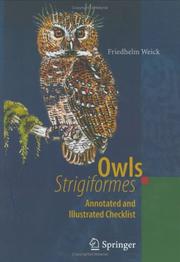
ISBN: 1281043990 9786611043995 3540395679 3540352341 3642071228 Year: 2006 Publisher: Berlin ; New York : Springer,
Abstract | Keywords | Export | Availability | Bookmark
 Loading...
Loading...Choose an application
- Reference Manager
- EndNote
- RefWorks (Direct export to RefWorks)
The owl is a magical creature: it exudes an ambivalent fascination that can trigger completely antithetical responses. On the one hand, there is something unsettling about the owl’s soundless flight, eerie call, and nocturnal activity that can result in its demonization as a messenger of darkness. On the other hand, however, its masklike visage and seemingly penetrating gaze prove - thralling, and this may have contributed to the deification of the owl as the companion spirit of an omniscient mother earth. In addition, the highly s- cialized captor of prey aroused the competitive envy of hunting parties, even provoking a bit of resentment when they lost out to owls in their hunt for small game. Moreover, the excrement and pellets (hairballs) they deposited in barns and church towers contributed to their reputation as undesirables or even pests. With the overcoming of superstition and suspicion, our relati- ship with these creatures of the night has now become one of unreserved - miration. They grant us insights into the rich diversity of adaptation to n- turnal hunting as well as into sound inventories, brooding biology, and ne- ling development. In a complete transformation of what was once a symbol of fear and hatred, charismatic owls now enjoy an almost singular popularity in large parts of the population.
Owls --- Striges --- Strigiformes --- Birds --- Zoology. --- Vertebrates. --- Biodiversity. --- Animal Systematics/Taxonomy/Biogeography. --- Biological diversification --- Biological diversity --- Biotic diversity --- Diversification, Biological --- Diversity, Biological --- Biology --- Biocomplexity --- Ecological heterogeneity --- Numbers of species --- Vertebrata --- Chordata --- Natural history --- Animals --- Animal systematics. --- Animal taxonomy. --- Animal classification --- Animal systematics --- Animal taxonomy --- Classification --- Systematic zoology --- Systematics (Zoology) --- Taxonomy, Animal --- Zoological classification --- Zoological systematics --- Zoological taxonomy --- Zoology
Book
ISBN: 354072446X 3540724451 3642091520 Year: 2008 Publisher: Berlin ; New York : Springer,
Abstract | Keywords | Export | Availability | Bookmark
 Loading...
Loading...Choose an application
- Reference Manager
- EndNote
- RefWorks (Direct export to RefWorks)
Lagomorphs are a mammalian order which includes rabbits, hares and pikas. They are distributed throughout the world and are of both scientific and public interest as they are classified between endangered and pest species. In addition, some have a high economic value as important game species. In the last few decades, a huge amount of information was made available to the scientific community and resulted in remarkable advances on all aspects of Lagomorph biology. However, this information is dispersed in multiple scientific and non-scientific journals. This book provides an updated synthesis of the current knowledge on Lagomorph biology.
Lagomorpha. --- Lagomorphs --- Duplicidentata --- Mammals --- Zoology. --- Animal ecology. --- Animal Ecology. --- Animal Systematics/Taxonomy/Biogeography. --- Animals --- Zoology --- Ecology --- Biology --- Natural history --- Animal systematics. --- Animal taxonomy. --- Animal classification --- Animal systematics --- Animal taxonomy --- Classification --- Systematic zoology --- Systematics (Zoology) --- Taxonomy, Animal --- Zoological classification --- Zoological systematics --- Zoological taxonomy
Book
ISBN: 1402098065 9786612036293 1282036297 1402098073 Year: 2009 Publisher: [Dordrecht] : Springer,
Abstract | Keywords | Export | Availability | Bookmark
 Loading...
Loading...Choose an application
- Reference Manager
- EndNote
- RefWorks (Direct export to RefWorks)
This summary of the results of chromosomal analysis of various groups of parasitic wasps will be essential reading for those working in the field. It is the second edition of a monograph that was first published in Russian, and has been substantially updated with new data, conclusions and references. The goal of this ground-breaking work is to document the author’s study of the karyotype structure and chromosomal evolution of parasitic Hymenoptera. It also interprets the results obtained, from both routine and differential chromosome staining, for systematic and phylogenetic purposes. Despite the huge importance of parasitic wasps, many problems of their taxonomy remain insufficiently studied. This is a situation that needs rectifying, as Hymenoptera are one of the largest and most taxonomically complicated groups of insects and they play a very important role in food chains as parasitoids of the overwhelming majority of insects and other arthropods. Parasitic wasps attack many pests of agriculture and forestry as well as certain beneficial insects. In addition, some secondarily phytophagous Hymenoptera damage certain cultivated plants. The renowned entomologist and author of this volume, Vladimir Gokhman, has himself developed a particular technique for obtaining chromosomal preparations from adult parasitic wasps. This allowed the inclusion of a wide range of those insects into the study. The karyotypic features of the majority of superfamilies and families as well as many lower taxa of parasitic Hymenoptera are listed, while the plesiomorphic and apomorphic character states of chromosome sets of parasitic wasps are revealed. The structural features of karyotypes used for identifying and discriminating sibling species and similar forms are shown, as are the data on chromosome sets of about 400 species of parasitic Hymenoptera (including more than 200 micrographs). Also included is a comprehensive phylogenetic and taxonomic analysis of karyotypic information. This book is unique because it demonstrates a range of karyotypic data for an insect group that seemed unattainable in this respect not so long ago. Rich in new facts, techniques and ideas, it will be of use to all those interested in karyology and Hymenoptera.
Hymenoptera --Genetics. --- Karyotypes. --- Parasitic wasps --Genetics. --- Parasitic wasps --- Karyotypes --- Hymenoptera --- Invertebrates & Protozoa --- Zoology --- Health & Biological Sciences --- Genetics --- Hymenoptera. --- Symphyta --- Life sciences. --- Animal genetics. --- Entomology. --- Life Sciences. --- Animal Genetics and Genomics. --- Animal Systematics/Taxonomy/Biogeography. --- Insects --- Chromosome abnormalities --- Chromosomes --- Cytotaxonomy --- Animal systematics. --- Animal taxonomy. --- Animal classification --- Animal systematics --- Animal taxonomy --- Classification --- Systematic zoology --- Systematics (Zoology) --- Taxonomy, Animal --- Zoological classification --- Zoological systematics --- Zoological taxonomy --- Animals
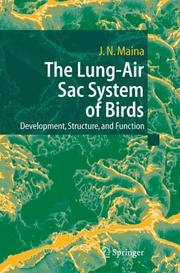
ISBN: 1280413034 9786610413034 3540297278 3540255958 3642065015 Year: 2005 Publisher: Berlin : Springer-Verlag,
Abstract | Keywords | Export | Availability | Bookmark
 Loading...
Loading...Choose an application
- Reference Manager
- EndNote
- RefWorks (Direct export to RefWorks)
In biology, few organs have so eluded understanding as the lung-air sac system of birds. Considerable progress recently has been made in filling the gaps in knowledge, however. While summarizing and building on earlier observations and ideas, this book provides cutting-edge details on the development, structure, function, and evolutionary design of the avian respiratory system. Outlining the mechanisms and principles through which biological complexity and functional novelty have been crafted in a unique gas exchanger, this account will provoke further inquiries on the many still-unanswered questions. The specific goal of the book is to highlight the uniqueness of the design of the avian respiratory system and the factors that led to its development.
Air sacs (Bird anatomy) --- Birds --- Respiratory organs. --- Air-sacs (of birds) --- Sacs, Air (Bird anatomy) --- Respiratory organs --- Animal physiology. --- Zoology. --- Morphology (Animals). --- Animal Physiology. --- Animal Anatomy / Morphology / Histology. --- Animal Systematics/Taxonomy/Biogeography. --- Biology --- Natural history --- Animals --- Animal morphology --- Body form in animals --- Zoology --- Morphology --- Animal physiology --- Anatomy --- Physiology --- Animal anatomy. --- Animal systematics. --- Animal taxonomy. --- Animal anatomy --- Animal classification --- Animal systematics --- Animal taxonomy --- Classification --- Systematic zoology --- Systematics (Zoology) --- Taxonomy, Animal --- Zoological classification --- Zoological systematics --- Zoological taxonomy
Book
ISBN: 1281397873 9786611397876 1402081766 1402081758 9048177936 Year: 2008 Publisher: Dordrecht ; London : Springer,
Abstract | Keywords | Export | Availability | Bookmark
 Loading...
Loading...Choose an application
- Reference Manager
- EndNote
- RefWorks (Direct export to RefWorks)
This work was begun to provide keys to the aquatic insect species known from Brazil. The original goal was to include all genera known from South America and all species from Brazil, but for most groups, the scope was expanded to encompass all species in South America, and, in some cases, to include terrestrial species of orders that include both terrestrial and aquatic taxa. In no case is a taxonomic revision of any group undertaken, although recommendations for such revisions are included where appropriate, and the probable synonymy of nominal species still treated as valid in the literature is noted. Two different approaches will be employed according to the taxon being treated. For phylogenetic groups encompassing overwhelmingly or exclusively aquatic species, such as the orders Plecoptera and Ephemeroptera or the families Dytiscidae and Culicidae, keys are provided to distinguish all genera and species known to occur in South America. An effort has been made to include every identifiable species so that the user of the key can determine with reasonable certainty whether or not his specimen belongs to a species that has already been described or whether it is one that is not yet known to science. Where feasible, complete keys will be prepared for groups containing both aquatic and terrestrial species that do not encompass an extraordinarily large number of species. This has already been done for the order Collembola.
Aquatic insects --- Damselflies --- Damsel flies --- Zygoptera --- Odonata --- Insects, Aquatic --- Water insects --- Aquatic invertebrates --- Insects --- Entomology. --- Zoology. --- Aquatic biology. --- Animal ecology. --- Freshwater & Marine Ecology. --- Animal Systematics/Taxonomy/Biogeography. --- Animal Ecology. --- Animals --- Zoology --- Ecology --- Hydrobiology --- Water biology --- Aquatic sciences --- Biology --- Natural history --- Aquatic ecology . --- Animal systematics. --- Animal taxonomy. --- Animal classification --- Animal systematics --- Animal taxonomy --- Classification --- Systematic zoology --- Systematics (Zoology) --- Taxonomy, Animal --- Zoological classification --- Zoological systematics --- Zoological taxonomy --- Aquatic biology
Book
ISBN: 1281512524 9786611512521 1402082398 140208238X Year: 2008 Publisher: New York : Springer,
Abstract | Keywords | Export | Availability | Bookmark
 Loading...
Loading...Choose an application
- Reference Manager
- EndNote
- RefWorks (Direct export to RefWorks)
The third edition of The Ciliated Protozoa continues the innovative approach of the previous two editions, thoroughly documenting the progress in our understanding of the evolutionary diversification of these widely distributed eukaryotic microorganisms. The Glossary is considerably revised and expanded, serving as an illustrated ‘subject index’ of more than 700 terms. An introduction to the phylum is followed by chapters on the 11 classes. Each class chapter contains 7 sections: taxonomic structure life history and ecology somatic structures oral structures division and morphogenesis nuclei, sexuality, and life cycle other features The book includes new data on the ultrastructure of the somatic cortex of each class, molecular phylogenetics, ecology, and on other important aspects of ciliate biology. These new data are used, along with a novel conceptual approach, to rationalize a new system of classification for the phylum, presented in a major chapter on The Ciliate Taxa. The book includes an up-to-date bibliography of approximately 3,000 citations to both the ‘classical’ and recent literature, and both a Subject Index and a Systematic Index. This unique and timely book will serve as a comprehensive and authoritative reference work for students, teachers, and researchers who have an interest in the protozoa, and particularly the ciliates. As an additional feature, all figures are available electronically for free viewing on the book's homepage at www.springer.com/978-1-4020-8238-2, under Additional Information. .
Ciliata --- Ciliated protozoa --- Ciliophora --- Protozoa --- Invertebrates. --- Microbiology. --- Ecology. --- Microbial ecology. --- Cytology. --- Eukaryotic Microbiology. --- Animal Systematics/Taxonomy/Biogeography. --- Microbial Ecology. --- Cell Biology. --- Cell biology --- Cellular biology --- Biology --- Cells --- Cytologists --- Environmental microbiology --- Microorganisms --- Ecology --- Microbiology --- Balance of nature --- Bionomics --- Ecological processes --- Ecological science --- Ecological sciences --- Environment --- Environmental biology --- Oecology --- Environmental sciences --- Population biology --- Microbial biology --- Invertebrata --- Animals --- Animal systematics. --- Animal taxonomy. --- Ecology . --- Cell biology. --- Animal classification --- Animal systematics --- Animal taxonomy --- Classification --- Systematic zoology --- Systematics (Zoology) --- Taxonomy, Animal --- Zoological classification --- Zoological systematics --- Zoological taxonomy --- Zoology
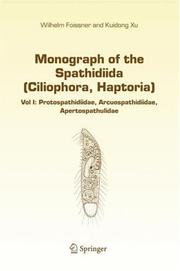
ISBN: 9400788533 1402042108 9786610816712 1280816716 1402047355 Year: 2007 Publisher: Dordrecht : Springer Netherlands : Imprint: Springer,
Abstract | Keywords | Export | Availability | Bookmark
 Loading...
Loading...Choose an application
- Reference Manager
- EndNote
- RefWorks (Direct export to RefWorks)
The spathidiids belong to the ciliate subclass Haptoria (Protozoa, Ciliophora), that is, they are predators using toxicysts to overwhelm the prey. Over 200 nominal spathidiid species have been described, sometimes based on seemingly minute differences. Thus, many protozoologists considered them as indeterminable and claimed for a detailed revision. The present monograph carefully revises the taxonomy, nomenclature, and ecology of all nominal species and shows that spathidiid diversity has been greatly underestimated. Based on the reinvestigation of described species with modern methods (silver impregnation, scanning electron microscopy) and the first description of over 50 new species, the family Spathidiidae is split into four families and 20 genera. Each species is described and figured in detail, making it unnecessary to go back to the original literature often difficult to obtain. Two identification keys are provided, viz., one for taxonomists and another, simple key for users not specifically trained in ciliate taxonomy.
Ciliata -- Classification. --- Spathidiidae -- Classification. --- Spathidiidae --- Ciliata --- Zoology - General --- Invertebrates & Protozoa --- Zoology --- Health & Biological Sciences --- Ciliated protozoa --- Ciliophora --- Bryophyllidae --- Homalozoidae --- Legendreidae --- Perispiridae --- Life sciences. --- Biodiversity. --- Zoology. --- Life Sciences. --- Animal Systematics/Taxonomy/Biogeography. --- Biology --- Natural history --- Animals --- Biological diversification --- Biological diversity --- Biotic diversity --- Diversification, Biological --- Diversity, Biological --- Biocomplexity --- Ecological heterogeneity --- Numbers of species --- Animal systematics. --- Animal taxonomy. --- Animal classification --- Animal systematics --- Animal taxonomy --- Classification --- Systematic zoology --- Systematics (Zoology) --- Taxonomy, Animal --- Zoological classification --- Zoological systematics --- Zoological taxonomy
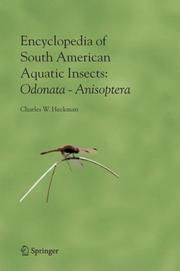
ISBN: 9781402048025 1280716436 9786610716432 1429414413 1402048025 1402048017 Year: 2006 Publisher: Dordrecht : Springer,
Abstract | Keywords | Export | Availability | Bookmark
 Loading...
Loading...Choose an application
- Reference Manager
- EndNote
- RefWorks (Direct export to RefWorks)
Anisoptera is the first of two volumes on the Odonata in the series Encyclopedia of South American Aquatic Insects. The second will treat the Zygoptera. The Anisoptera volume encompasses the large dragonfly species. A brief review of the biology of the group includes illustrations of the main morphological features as well as explanations of alternative systems for naming the wing veins and other structures. This will prepare the user of the volume to understand the different names for the same structures that he will encounter in the literature. The review is then followed by keys to facilitate identification of the adult dragonflies and the known larvae, allowing the user a high probability of identifying his specimens correctly. In addition to anatomical features, the keys include the known ranges of the species, synonyms, and citations of literature in which more information about each individual species can be obtained. These citations are compiled in an extensive bibliography, including titles of the original publications in which descriptions of almost all South American species appeared. Although taxonomic revisions are deliberately avoided, suggestions for additional research are provided where the validity of taxa seems doubtful. To provide the user with the best possible opportunity to distinguish the species, the keys are richly illustrated with pen and ink drawings of thousands of individual morphological structures arranged in 797 figures. It is certain that significant changes will occur in the systematics of South American dragonflies in the future, and this book should provide the impetus needed to accelerate the revisional work. Meanwhile, it will provide a comprehensive overview of the Anisoptera in South America that is otherwise unavailable to most South American scientists because of the great difficulties in obtaining the hundreds of publications from numerous countries in which the descriptions and revisions of the species appeared. It also provides young entomologists with a basic text for learning what they need to know to work effectively with the Anisoptera of South America and adjacent regions. Already published within this encyclopedia: -Encyclopedia of South American Aquatic Insects: Collembola ISBN: 0-7923-6704-9 -Encyclopedia of South American Aquatic Insects: Ephemeroptera ISBN: 1-4020-0775-2 -Encyclopedia of South American Aquatic Insects: Plecoptera ISBN: 1-4020-1520-8 Forthcoming book titles: Forthcoming book titles: -Encyclopedia of South American Aquatic Insects: Odonata - Zygoptera -Encyclopedia of South American Aquatic Insects: Orthoptera -Encyclopedia of South American Aquatic Insects: Heteroptera; -Encyclopedia of South American Aquatic Insects: Neuroptera, including Megaloptera -Encyclopedia of South American Aquatic Insects: Trichoptera -Encyclopedia of South American Aquatic Insects: Lepidoptera -Encyclopedia of South American Aquatic Insects: Coleoptera -Encyclopedia of South American Aquatic Insects: Diptera -Encyclopedia of South American Aquatic Insects: Hymenoptera.
dierenecologie --- hydrobiologie --- nomenclatuur --- Zoology --- zoölogie --- Animal systematics, taxonomy, nomencl. --- Hydrobiology --- Animal ethology and ecology. Sociobiology --- Odonata --- Dragonflies --- Anisoptera --- Libelluloidea --- Odes (Insects) --- Odonates --- Paraneuroptera --- Insects --- Entomology. --- Animal ecology. --- Aquatic biology. --- Zoology. --- Animal Ecology. --- Animal Systematics/Taxonomy/Biogeography. --- Freshwater & Marine Ecology. --- Biology --- Natural history --- Animals --- Water biology --- Aquatic sciences --- Ecology --- Animal systematics. --- Animal taxonomy. --- Aquatic ecology . --- Aquatic biology --- Animal classification --- Animal systematics --- Animal taxonomy --- Classification --- Systematic zoology --- Systematics (Zoology) --- Taxonomy, Animal --- Zoological classification --- Zoological systematics --- Zoological taxonomy
Book
ISBN: 1280312157 9786610312153 1402032404 Year: 2005 Volume: 180 Publisher: Dordrecht ; [Great Britain] : Springer,
Abstract | Keywords | Export | Availability | Bookmark
 Loading...
Loading...Choose an application
- Reference Manager
- EndNote
- RefWorks (Direct export to RefWorks)
Recently, evidence has been accumulated which shows that some of the groups formerly regarded as independent "phyla" such as Pogonophora (now recognized as Siboglinidae), Echiura, Myzostomida and perhaps Sipuncula, are most probably nothing else than greatly modified Annelida. The extreme morphological diversity found especially in Polychaeta displays the plasticity of a simple segmented organisation that basically is nothing else but a serial repetition of identical units. Thus, annelids are highly important to our understanding of fundamental questions about morphological and adaptive diversity, as well as clarifying evolutionary changes and phylogenetic relationships. The book aims to summarize our knowledge on Polychaetes polychaetes and their allies and gives an overview of recent advances gained by studies that employed conventional and modern methods plus, increasingly and importantly, the use of molecular markers and computer-assisted kinship analyses. It also reflects the state of art in polychaete sciences and presents new questions and controversies. As such it will significantly influence the direction of research on Polychaeta and their related taxa.
Polychaeta --- Morphology. --- Phylogeny. --- Evolution. --- Archiannelida --- Chaetopoda --- Polychaete worms --- Polychaetes --- Polychetes --- Annelida --- Invertebrates. --- Aquatic biology. --- Evolution (Biology). --- Zoology. --- Morphology (Animals). --- Freshwater & Marine Ecology. --- Evolutionary Biology. --- Animal Anatomy / Morphology / Histology. --- Animal Systematics/Taxonomy/Biogeography. --- Animal morphology --- Animals --- Body form in animals --- Zoology --- Morphology --- Biology --- Natural history --- Animal evolution --- Biological evolution --- Darwinism --- Evolutionary biology --- Evolutionary science --- Origin of species --- Evolution --- Biological fitness --- Homoplasy --- Natural selection --- Phylogeny --- Hydrobiology --- Water biology --- Aquatic sciences --- Invertebrata --- Aquatic ecology . --- Evolutionary biology. --- Animal anatomy. --- Animal systematics. --- Animal taxonomy. --- Animal classification --- Animal systematics --- Animal taxonomy --- Classification --- Systematic zoology --- Systematics (Zoology) --- Taxonomy, Animal --- Zoological classification --- Zoological systematics --- Zoological taxonomy --- Animal anatomy --- Physiology --- Aquatic biology --- Ecology --- Anatomy
| Listing 1 - 10 of 26 | << page >> |
Sort by
|

 Search
Search Feedback
Feedback About UniCat
About UniCat  Help
Help News
News